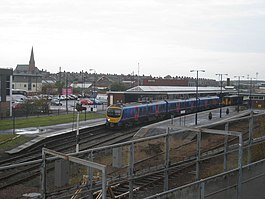Barrow-in-Furness railway station
| Barrow-in-Furness |
|
|---|---|

The station viewed from Abbey Road
|
|
| Location | |
| Place | Barrow-in-Furness |
| Local authority | Barrow-in-Furness |
| Coordinates | 54°07′08″N 3°13′34″W / 54.119°N 3.226°WCoordinates: 54°07′08″N 3°13′34″W / 54.119°N 3.226°W |
| Grid reference | SD199699 |
| Operations | |
| Station code | BIF |
| Managed by | Northern |
| Number of platforms | 3 |
| DfT category | D |
| Live arrivals/departures, station information and onward connections from National Rail Enquiries |
|
| Annual rail passenger usage* | |
| 2011/12 |
|
| – Interchange |
|
| 2012/13 |
|
| – Interchange |
|
| 2013/14 |
|
| – Interchange |
|
| 2014/15 |
|
| – Interchange |
|
| 2015/16 |
|
| – Interchange |
|
| National Rail – UK railway stations | |
| * Annual estimated passenger usage based on sales of tickets in stated financial year(s) which end or originate at Barrow-in-Furness from Office of Rail and Road statistics. Methodology may vary year on year. | |
|
|
|
Barrow-in-Furness railway station is the largest railway station serving Barrow-in-Furness in Cumbria, England. It is the western terminus of the Furness Line to Lancaster and the southern terminus of the Cumbrian Coast Line to Carlisle, both of which connect to the West Coast Mainline. It is operated by Northern.
The present station was formerly known as Barrow Central and at one time it was a terminus for British Rail long-distance or InterCity services. From October 1947 until May 1983 these included sleeper services to and from London Euston. A sleeper service in the London direction only was briefly reintroduced between May 1987 and May 1990.
The original Barrow station of 1846 had been a wooden building at Rabbit Hill, near the site of the present St. George's Square. It was eventually replaced in 1863 by a new brick building close by, which had been designed by the Lancaster architect Edward Paley, and which latterly came to be known as Cambridge Hall. On 1 June 1882, the town's principal station was transferred to its present site below Abbey Road, following the construction of a new loop line. It had to be almost entirely rebuilt in the late 1950s, after World War II, having largely been destroyed by enemy bombing on 7 May 1941. From 1907–1941, the Furness Railway steam locomotive "Coppernob" was preserved in a special glass case outside the station. It was subsequently transferred away for additional security and is now in the National Railway Museum at York.
...
Wikipedia
